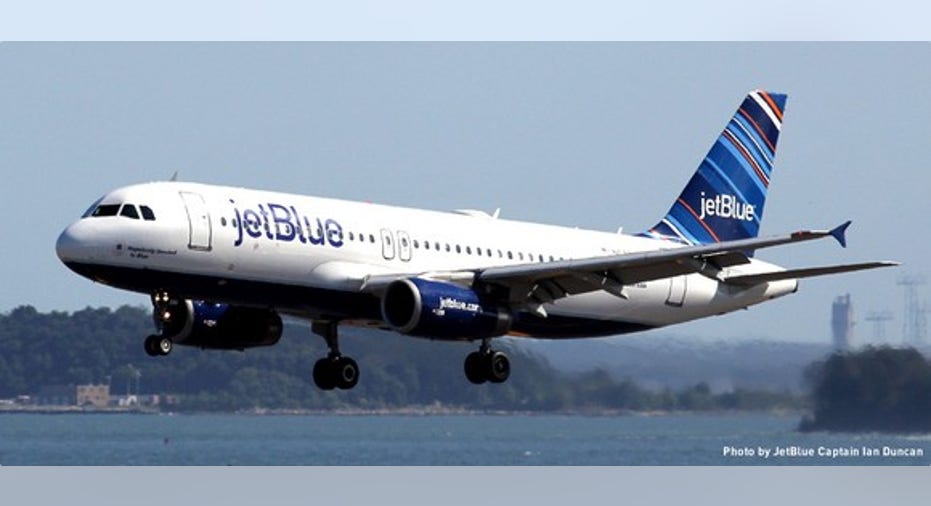JetBlue's Fleet Plan Shows Growth Is Still on the Menu

Like many of its competitors, JetBlue Airways (NASDAQ: JBLU) has slowed its growth in the past few months. For Q4, the company expects to increase its capacity 3%-5% year over year, compared to its double-digit growth rate in the first three quarters of 2016.
JetBlue has slowed its growth rate recently -- but not for long. Image source: JetBlue Airways.
This slowdown in capacity growth is already helping to get unit revenue on the right track. For November, revenue per available seat mile was roughly flat year over year: the best result since late 2015. Nevertheless, JetBlue's fleet plan for the next several years indicates that the company plans to return to a faster pace of expansion in the near future.
JetBlue starts ordering planes again
In late 2014, JetBlue made plans to moderate its growth rate, deferring 18 aircraft that Airbus (NASDAQOTH: EADSY) was originally scheduled to deliver between 2016 and 2018.
However, over the past year, JetBlue essentially reversed that decision by adding dozens of extra planes to its fleet plan. First, the company leased two extra A321s, in order to support its new flights to Cuba.
Second, JetBlue ordered 15 more A321s and 15 additional A321neos from Airbus in July. The current-generation A321s will arrive between 2017 and 2019 and will almost entirely reverse the previous order deferral.
Looking at JetBlue's new fleet plan
JetBlue now plans to take delivery of 15 Airbus A321s during 2017 and another 11 A321s in 2018. About 70% of the 2017 deliveries will come in the second half of the year. That will help offset the impact of lower utilization for JetBlue's A320 fleet as the company begins retrofitting those planes with two extra rows of seats. It also means that a sizable chunk of the capacity growth from JetBlue's 2017 fleet expansion will actually come in 2018.
JetBlue will start retrofitting its A320s with extra seats later this year. Image source: JetBlue Airways.
As a result, this delivery schedule positions JetBlue to maintain a fairly steady high single-digit growth rate for the next two years. For 2017 specifically, JetBlue plans to increase its capacity 6.5%-8.5% year over year.
In 2019, JetBlue's capacity growth could accelerate again. The company has 21 Airbus aircraft on order for that year, consisting of three A321s and 18 A321neos. The A320 retrofit program -- which will add 12 seats to each of JetBlue's more than 100 A320s -- will also start to have a meaningful impact on capacity in 2019.
This means that JetBlue's capacity growth rate could reach double-digit territory again in 2019. The carrier could moderate its expansion pace by allowing leases on some of its older Airbus planes to expire. Still, after buying numerous previously leased aircraft in recent years, JetBlue only has 15 A320 leases scheduled to expire between now and 2023. Furthermore, it has already budgeted some money to buy more of its leased aircraft this year.
Will Mint live up to its promise?
JetBlue is in the midst of aggressively expanding its "Mint" transcontinental service, which features a premium cabin with 16 flat-bed seats. So far, Mint has been a huge success for the carrier. Over the next year and a half, JetBlue will dramatically expand its specially configured fleet of A321s while switching to Mint service on more than a half-dozen routes.
Customers love JetBlue's new flat-bed premium seats. Image source: JetBlue Airways.
The profitability of this Mint service expansion will determine whether or not JetBlue accelerates its growth rate in 2019. If JetBlue's premium offering continues to be a home run, the company will probably want to add flights on its existing Mint routes while converting more transcon routes to Mint service.
Additionally, Airbus' A321LR -- an extended-range version of the A321neo that will be capable of transatlantic flights -- will become available in 2019. JetBlue has the option to convert some of its A321neo delivery slots to the A321LR, which would allow it to expand into Europe with Mint service.
Thus, JetBlue's growth opportunities will increase at the same time its capacity expansion is set to accelerate. JetBlue is scheduled to receive an average of nearly 20 new Airbus aircraft each year from 2020 to 2022, so it is well-positioned to continue growing at a rapid pace beyond 2020.
Despite its superb growth opportunities, JetBlue Airways continues to trade at a very modest valuation of less than 12 times forward earnings. That's why JetBlue stock is one of my top picks for 2017 and one of the biggest holdings in my investment portfolio.
10 stocks we like better than JetBlue Airways When investing geniuses David and Tom Gardner have a stock tip, it can pay to listen. After all, the newsletter they have run for over a decade, Motley Fool Stock Advisor, has tripled the market.*
David and Tom just revealed what they believe are the 10 best stocks for investors to buy right now... and JetBlue Airways wasn't one of them! That's right -- they think these 10 stocks are even better buys.
Click here to learn about these picks!
*Stock Advisor returns as of Nov. 7, 2016
Adam Levine-Weinberg owns shares of JetBlue Airways and is long January 2017 $17 calls on JetBlue Airways. The Motley Fool recommends JetBlue Airways. The Motley Fool has a disclosure policy.